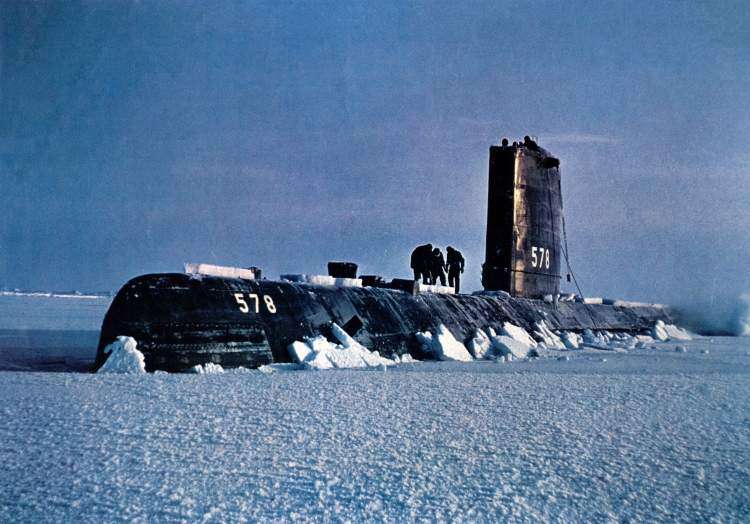The quest to conquer the North Pole has captivated explorers throughout history, and in the 20th century, two pioneering submarines, the USS Nautilus and the USS Skate, pushed the boundaries of human achievement by venturing into the treacherous waters of the Arctic Ocean.

These groundbreaking expeditions represented significant milestones in both military capabilities and scientific exploration.
USS Nautilus
The story begins with the USS Nautilus. This vessel conducted its own groundbreaking journey to the North Pole just a week before the USS Skate.
The USS Nautilus was commissioned in 1954 and was the United States first ever nuclear powered submarine.
She represented a significant leap forward in submarine technology. Its construction and revolutionary nuclear propulsion system revolutionized naval capabilities and paved the way for unparalleled achievements in underwater exploration.
The Nautilus was constructed at the Electric Boat Division of General Dynamics Corporation in Groton, Connecticut, under the guidance of Admiral Hyman G. Rickover, a visionary naval officer who played a crucial role in developing nuclear-powered vessels.

Operation Sunshine
Operation Sunshine, the Nautilus’ mission to the North Pole, was conceived as a strategic and symbolic endeavor for the United States.
The voyage aimed to showcase the country’s technological prowess, bolster national security interests, and expand scientific knowledge of the Arctic region.
Setting sail from Pearl Harbor, Hawaii, on July 23, 1958, the Nautilus embarked on its journey to the North Pole.
The submarine made its way through the Bering Strait, the narrow waterway separating Alaska and Russia, and entered the Arctic Ocean.
As the Nautilus ventured further north, it encountered the formidable challenges posed by the Arctic environment.
The submarine had to navigate through shifting ice formations, endure extreme cold temperatures, and constantly monitor the thickness and stability of the ice to ensure the safety of the vessel.
 USS Skate in the arctic circle.
USS Skate in the arctic circle.
Operation Sunshine presented an opportunity for extensive scientific research and data collection.
The Nautilus was equipped with advanced sonar systems and other scientific instruments to gather information about the Arctic environment.
The crew conducted measurements of water temperature, salinity, and other oceanographic parameters.
They also collected valuable data on the ice cover, studying its thickness and variations.
After weeks of navigating through the harsh Arctic waters and travelling nearly 1,000 miles underwater, the USS Nautilus achieved a historic milestone.
On August 3, 1958 – the first ever operational nuclear powered submarine also became the first ever submarine to reach the North Pole.
However, the Nautilus would not surface at Pole.
USS Skate
Construction of the USS Skate began on April 21, 1955, and the submarine was launched on December 2, 1957. Like the Nautilus before her, the Skate was also built by General Dynamics Corporation in Groton, Connecticut.
She was commissioned into the United States Navy on December 23, 1957, becoming the third nuclear powered submarine to be commissioned into the Navy.
 USS Skate in Rotterdam, 1958.
USS Skate in Rotterdam, 1958.
Within a week of the Nautilus setting sail from Pearl Harbor on its historic voyage to the North Pole, the USS Skate also undertook its own expedition to the Pole. However, the objectives of the Skate differed from that of the Nautilus.
The Skate aimed to achieve the distinction of being the first submarine to surface at the North Pole.
On August 11th, the Skate reached its destination. However, the perilous icy conditions prevailing at the time posed a significant risk to the vessel, preventing it from surfacing at the precise location as planned.
The Second Journey
In early 1959, the USS Skate was poised once again for the North Pole. She followed the same course as her last journey – through the Bering straight and into the Arctic.
This time, the vessel travelled over 2,000 miles under water.
The USS Skate reached the North Pole for the second time on 17 March, 1959. This time, the vessel was able to break through the ice and surface. It is worth noting that this time of the year is when polar conditions are particularly cold and the ice extremely thick.
 USS Skate surfaced in the Arctic.
USS Skate surfaced in the Arctic.
The crew planted an American flag and ceremonially spread the ashes of the Australian Polar Explorer Sir George Hubert Wilkins.
USS Skate After The Expedition
When the Skate returned to port, she was awarded with the Bronze star for demonstrating ‘… for the first time the ability of submarines to operate in and under the Arctic ice in the dead of winter…’.
The vessel took part in submarine defense exercises in 1959 and 1960 and then returned to General Dynamics for an overhaul.
In 1962, the Skate headed to the North Pole again. This time, she would rendezvous with the submarine USS Seadragon, where they would both surface at the North Pole on 31 July 1962.
 USS Skate and USS Seadragon after surfacing in the Arctic.
USS Skate and USS Seadragon after surfacing in the Arctic.
What Happened to The USS Skate?
The USS Skate may no longer be sailing the seas, but its legacy still lives on. This submarine served with distinction during its active years, earning numerous accolades and commendations along the way.
But like all ships, USS Skate also reached the end of its operational lifespan. USS Skate decommissioned on September 12 in 1986.
After being decommissioned, it was stricken from the Naval Vessel Register on October 30, 1986, and eventually recycled at the Puget Sound Naval Shipyard on March 6th, 1995
Conclusion
The journeys of the USS Nautilus and the USS Skate to the North Pole were monumental achievements in human exploration and scientific progress.
These pioneering submarines demonstrated the indomitable spirit of human curiosity, pushing the boundaries of what was deemed possible.
News
A Creative Journey: Lady Gaga’s Artistic Growth and Fearless Embrace of Individuality
The weirdness and craziness of star Lady Gaga’s outfits have been increasing every day. Even if she were dressed in rags and beggar clothes, no one would be surprised. Lady Gaga created her own unique, shocking fashion line that no…
Gaga’s Street Style: No Bras, Semi-Sheer Top, and Daring Daisy Dukes in NYC
Lady Gaga recently unveiled the much-anticipated track list for her latest album, Joanne, and she is certainly not shying away from the limelight. The singer was spotted in New York on Saturday confidently flaunting her unique fashion sense. Her daring…
VIDEO : Unexpected Flashback: Old Footage Resurfaces Showing Lady Gaga’s Unusual On-Stage Act with a Girl Vomiting on Her Chest
It’s come back up. A clip of a woman making herself vomit on Lady Gaga during her SXSW performance in 2014 has resurfaced online — and the bile hasn’t aged well. Gaga, 36, incorporated performance artist Millie Brown into her choreography…
My First Piano Teacher Was a Stripper’: Lady Gaga Reveals Dad Hired a Stripper as Her Music Teacher, Linking it to Her Signature Long Nails
Lady Gaga is one of the popular artists who’s known for image reinventions and musical versatility. She rose to fame with her debut studio album, The Fame in 2007 with its chart-topping singles Just Dance and Poker Face. She is not only…
20 Bizarre Photos Prove That Lady Gaga Is The Most Unhinged Fashion Icon Ever
One of the most iconic and multi-talented artists of our time, Lady Gaga, with worldwide hits such as Bad Romance, Judas, and Born This Way, is also known as a composer, an actress, and above all, a fashionista. Known as…
Lady Gaga Goes Makeup-Free for Oscars Performance, Letting People See the Real Her
Oscars executive producer reveals Lady Gaga decided to go makeup-free during her performance to show people the ‘real’ her. Featured Image Credit: ABC Yesterday (March 13), the musician stunned viewers with a performance of the Oscar-nominated song ‘Hold My Hand’…
End of content
No more pages to load











